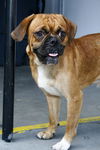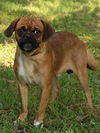Welcome to Pet Rescue By Judy!
401 South Laurel Avenue
Sanford, FL 32771
(407) 302-4497
info@petrescuebyjudy.com
Coach the Puggle's Web Page

| My Rescue |
| Login to Remember your Favorite Animals and Breeds! |
Name: Coach the Puggle
Status: Adopted!
Adoption Fee: $300
Species: Dog
Breed: Pug / Beagle (medium coat)
Learn more about the Pug.Learn more about the Beagle.
Color: Tan with Black Muzzle
Sex: Male (neutered)
Current Size: 14 Pounds
Potential Size: 16 Pounds
General Potential Size: Small
Current Age: 15 Years 9 Months (best estimate)
Activity Level: Highly Active
Indoor or Outdoor: Indoor Only
Good with Dogs: Yes
Good with Cats: Yes
Good with Kids: Yes
Microchipped: Yes
Coach the Puggle's sister, Emma the Puggle (adopted) can also be seen on our website.
Description:
Coach and Emma are Puggles (Pug/Beagles) and were found as strays by one of our volunteers. They were both not fixed, covered in fleas, nails growing into there pads, and just lacking general up keep! They have since been fixed, cleaned and cared for.
Foster Update 8/30: Coach is a wonderful boy with no adverse behaviors that I have noticed. He loves to play, but is a real snuggler! Wants to be a lapdog. He loves to look out the windows and is calmer than the last puggle that I fostered. He hasn't had a single accident in my house. He does sneeze a bit, but an internet search says that is normal to a pug's more sensitive, short noses. He doesn't care for his kennel, but is eager to go in with a dog bone. Has a nice protective bark (versus a yip/yap). He seems young to me with younger looking teeth. He certainly acts like an older puppy. He isn't leash trained, loves toys and 'tug' and is learning to bring the ball back to me and not to choke himself on a walk with a leash. He is a great dog! Full of kisses. He snores and eyes get droopy when he is tired. He is so playful he would love another dog to play with. He knows hush and is learning sit. Smart, intuitive, happy, eager and wants to please. Would be great for kids-a nice mix of big dog personality with the ease of little dog care. I think he may develop loyalty and some protectiveness towards his adoptive kids.
According to www.dogbreedinfo.com, one of the older breeds, the Pug is believed to have originated before 400 BC in Asia. There is somewhat of a debate over the origin of the Pug. Some experts think it came from the Lowlands, brought back from the Far East by Dutch traders. It is possibly of Oriental stock, descended from a short-haired Pekingese, but another theory is, it is the result of crossing a small Bulldog. Yet another school of thought is that it is a miniature form of the rare French Mastiff called Dogue de Bordeaux. Pugs were a favorite of the artist Hogarth, who included his pet Pug "Trump" in several of his works. From the sixteenth century, it became a fashionable adornment of the European Courts, reaching its peak of popularity in Victorian times. He was a pet at Tibetan monasteries and later traveled to Japan. The Pug then came to Europe, where the endearing little dog was the pet of royalty in several countries and even became the official dog of the House of Orange in Holland. A Pug saved William, Prince of Orange's life by alerting him to the approaching Spaniards in 1572 at Hermingny. Napoleon's wife, Josephine, sent secret messages to her husband under the collar of her Pug while she was in prison. When the British overran the Chinese Imperial Palace in 1860, they discovered several Pugs and Pekinese, and brought the little dogs back to England with them. A Pug is "a lot of dog in a small space." They are perky, rambunctious and loyal, affectionate and loving, with a happy disposition. They are playful and charming. Clever and mischievous - with a heart-winning personality. They can be a bit willful. Highly intelligent, it bores easily with repetitive training practices. Pugs are sensitive to the tone of your voice, so harsh punishment is unnecessary. The dog is neither excitable nor dull. They are good watchdogs, very devoted and are not yappers. Pugs get along well with other dogs and pets, and they behave impeccably with both children and visitors. Do not forget though, that they require lots of attention and become jealous if their owner ignores them. They have an life expectancy of 12-15 years. A supporter of Pet Rescue By Judy e-mailed us this little Pug tidbit: " I learned additional knowlege about Pugs after a trip to my husband's homeland of Russia. I found that one of the greatest rulers of all time, Catherine the Great, had Pugs. In addition, she constructed a fountain in the royal home of St. Petersberg, home of Peter the Great, where a Pug travelled through a fountain catching ducks. I sat next to the fountain and had my picture taken."
Other Pictures of Coach the Puggle (click to see larger version):
 51.2k |
 45.1k |
 33.8k |
 62.3k |
 48.1k |
Copyright © Pet Rescue by Judy





